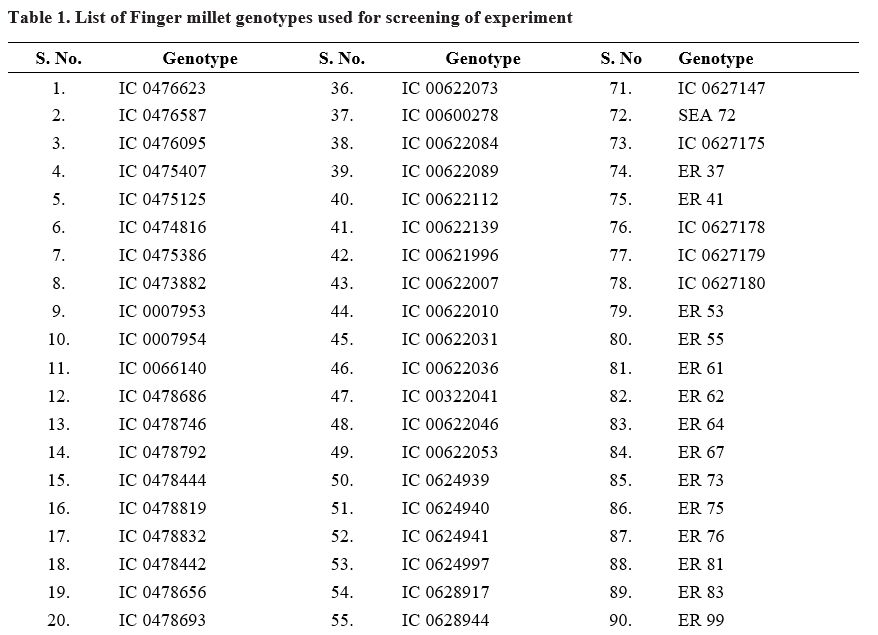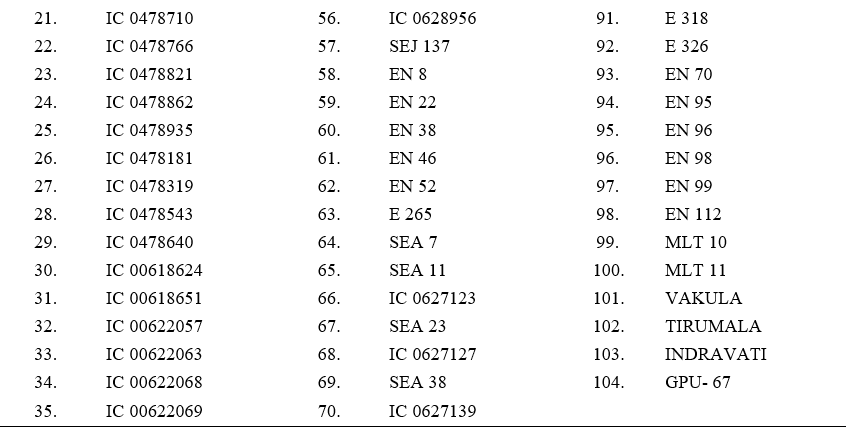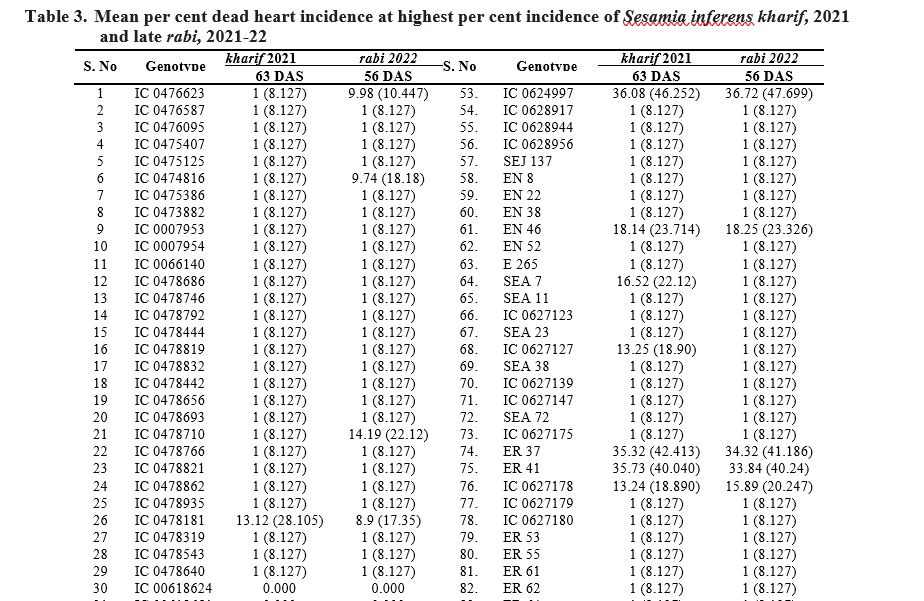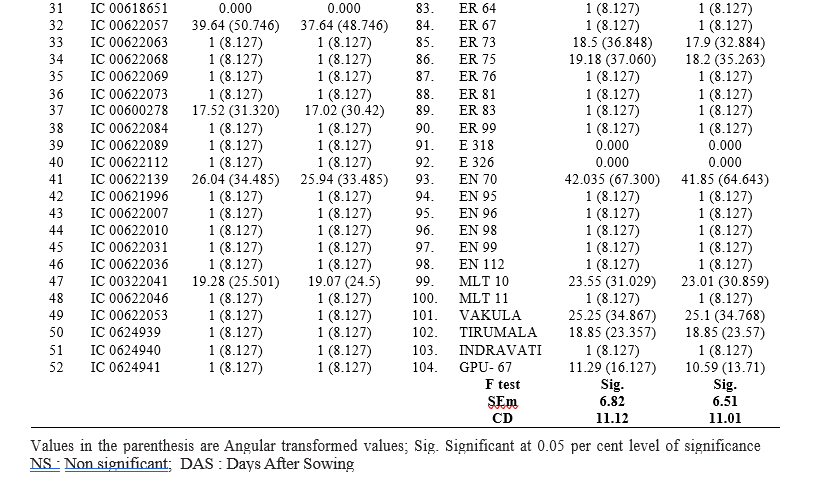Screening of Finger Millet (Eleusine Coracana) Genotypes Against Pink Stem Borer
0 Views
M. LOKESWARIDEVI*, K.V. HARI PRASAD, G.S. PANDURANGA, L. MADHAVI LATHA AND T.M. HEMA LATHA
Department of Entomology, S.V. Agricultural College, ANGRAU, Tirupati-517 502.
ABSTRACT.
A field trial was conducted at Agricultural Research Station, Perumalapalle, Tirupati District, Andhra Pradesh, India for evaluating 100 finger millet genotypes along with four varieties as check entries (Vakula, Tirumala, Indravati, GPU-67 for identification as a source of resistance against pink stem borer, during kharif 2021 and late rabi 2021-22. During kharif, 83 genotypes were placed under highly resistant category with <10 per cent dead heart incidence, 12 genotypes under moderately susceptible (10.1 – 40%) and five genotypes under highly susceptible category (>40%) to pink stem borer infestation. During late rabi 2021-22, 80 genotypes were placed under highly resistant category with <10 per cent dead heart incidence, 15 genotypes under moderately susceptible (10.1 to 40.0%) and five genotypes under highly susceptible (>40%) to pink stem borer.
KEYWORDS: Finger millet, pink stem borer, resistance, per cent dead heart.
INTRODUCTION
Finger millet, Eleusine coracana Gaertn, popularly known as ragi is popular among small millets (Finger millet, kodo millet, foxtail millet, barnyard millet, proso millet and little millet). It is a highly nutritive crop which can be cultivated in varying climatic conditions with minimum care and management. Its high fiber content, quality protein, mineral compositions are its distinctive nutritional properties that contribute significantly to its nutritional security. Finger millet is a hardy crop and has a quick rejuvenating capacity to various biotic and abiotic stresses and needs very little irrigation, has short crop cycle and is well suited for cultivation under adverse climatic conditions.
The dietary fiber, vitamins and polyphenols available in finger millet have several health benefits. The crop is gaining importance in recent years because of a rise in health awareness among diabetic and obese Indian population. Regulation of glucose homoeostasis and prevention in accumulation of high cholesterol can be achieved by regular intake of finger millet.
The crop is grown in India, Sri Lanka, Nepal, parts of Africa, Madagascar, Malaysia, Uganda, Japan etc., and 85 per cent of the world’s production is contributed from India. In India, finger millet is grown in an area of 1.19 m. ha with a production of 1.98 million tonnes giving an average productivity of 1661 kg per ha.
Karnataka accounts for 56.21 and 59.52 per cent of area and production of finger millet followed by Tamil Nadu (9.94% and 18.27%), Uttarakhand (9.40% and 7.76%) and Maharashtra (10.56% and 7.16%), respectively.
In Andhra Pradesh, it was grown over an area of 34 thousand hectares with a production of 44,880 tonnes with an average productivity of 1320 kg/ha in 2019-20 (indiastat.com, 2021). Major finger milletgrowingdistricts of Andhra Pradesh are Visakhapatnam. Vijayanagaram, Chittoor and Anantapur. Being a subsistence crop, finger millet does not attract the attention of synthetic insecticides and as such development of resistant varieties for insect pests and diseases is a cost effective and viable option that is environmentally friendly.
The potential for development of varieties with insect and disease resistance is enormous and is the need of the hour Efforts should be intensified to identify and improve germplasm or accessions or genotypes having in built resistance to biotic and abiotic stresses that can be effectively utilized in to breeding programmes for varietal improvement. In view of the importance and lack of related information on insect pest in finger millet particularly the ragi pink stem borer, the present investigations on “Studies on plant resistance in finger millet (Elesine coracana) to insect pest complex” was taken up with the following.
Experimental Material
The experimental material utilized for the present study comprised of 100 indigenous finger millet genotypes that were collected from various states of India for which the seed material was collected from IIMR
-Indian Institute of Millet Research, Hyderabad. The details of procurement of seed material the genotypes were presented in Table 1.
Crop raising
All the agronomic practices were adopted as per the recommendations of ANGRAU in raising the crop expect management practices during the experiment period. The experiment on screening of genotypes for insect resistance was carried out under field conditions by raising 100 Finger millet genotypes along with four check varieties i.e., Vakula. Tirumala, Indravati, GPU- 67 during kharif 2021 and late rabi 2021-22. Nursery was raised as per the recommended package of practices at ARS, Perumalapalle. Tirupati for field experiments. The nursery beds were well prepared by ploughing 4 or 5 times until fine tilth was achieved. The main field was ploughed thoroughly thrice with a tractor drawn cultivator and levelled after removing all the stubbles and weeds. The experiment was laid out in randomized block design (RBD) with 100 genotypes along with four check varieties. Each entry was replicated twice. In each replication the genotypes were sown in 2 rows of 3 meters length with a spacing of 22.5 cm between rows and 10 cm between the plants within the row. The fertilizers i.e., 60 kg N, 30 kg P2O5, and 20 kg K2O hectare-1 in the form of urea, single super phosphate and murate of potash, respectively were applied as basal dose as per recommendation. Irrigation and weeding operations were taken during crop growth period to raise good crop
Method of Observations
During the period of study, major insect that was observed was ragi pink stem borer and hence data was regarding per cent dead heart incidence due to pink stem borer is presented here. The incidence of ragi pink stem borer on different genotypes was recorded at weekly intervals. The data on the pest incidence i.e., dead hearts in each genotype and in each replication was recorded.
The data on per cent pest incidence was calculated by using the following formula:

Grouping of Genotypes Based on Per cent Dead Heart Incidence
Resistance or susceptibility of genotypes was categorized based on per cent dead heart incidence, following a three-point (1-3) rating scale given by Sekhar et al. (2016) (Table 2).
Statistical Analysis
The data on pest incidence in terms of per cent dead heart was subjected to angular transformations and analysed for getting Analysis of Variance (ANOVA) prescribed for randomized block design with the help of SPSS statistical package (SPSS, 2020).
RESULTS AND DISCUSSION
Response of Finger Millet Genotypes to pink stem borer incidence kharif 2021
Mean per cent dead heart incidence at weekly intervals kharif 2021
Number of dead hearts on different finger millet genotypes were recorded from 28 to 77 days after sowing at weekly intervals during kharif, 2021 (Table 3). The highest incidence of dead hearts by pink stem borer was observed at 63 DAS (36th meteorological week observation) in highly susceptible genotype EN 70 hence per cent dead hearts at 63 DAS was taken as a criteria for scoring of genotypes under different categories.
The reaction of 104 (100 test entries + four checks) finger millet genotypes against pink stem borer incidence was expressed as per cent dead hearts incidence. The per cent dead heart incidence in test genotypes was ranged from 8.13 to 67.3 with an average incidence of 15.52 per cent dead heart incidence during kharif, 2021 (Table 3). The genotypes were grouped into different resistance categories based on the per cent dead heart incidence at 63 DAS as given by Sekhar et al. (2016) (Table 2). 83 genotypes were placed under highly resistant category with <10 per cent dead heart incidence, 12 genotypes under moderately susceptible (10.1-40%) and five genotypes under highly susceptible category (>40%) to pink stem borer infestation. Four entries IC 00618624, IC 00618651, E 318 and E 326 were highly susceptible to blast and could not survive for getting data on dead heart incidence (Table 3).
The genotypes showing no dead hearts or <10 per cent incidence are viz., IC 0476623, IC 0476587, IC0476095, IC 0475407, IC 0475125, IC 0474816, IC ,0475386, IC 0473882, IC 0007953, IC 0007954, IC



0066140, IC 0478686, IC 0478746, IC 0478792, IC 0478444, IC 0478819, IC 0478832, IC 0478442, IC 0478656, IC 0478693, IC 0478710, IC 0478766, IC 0478821, IC 0478862, IC 0478935, IC 0478319, IC 0478543, IC 0478640, IC 00622063, IC 00622068, IC 00622069, IC 00622073, IC 00622084, IC 00622089, IC 00622112, IC 00621996, IC 00622007, IC 00622010, IC 00622031, IC 00622036, IC 00622046, IC 00622053, IC 0624939, IC 0624940, IC 0624941, IC 0628917, IC 0628944, IC 0628956, SEJ 137, EN 8, EN 22, EN 38, EN 52, E 265, SEA 7, SEA 11, IC 0627123, SEA 23, IC 0627127, SEA 38, IC 0627139, IC 0627147, SEA 72,\ IC 0627175, IC 627179, IC 0627180, ER 53, ER 55, ER 61, ER 62, ER 64, ER 67, ER 76, ER 81, ER 83, ER 99, EN 95, EN 96, EN 98, EN 99, EN 112, MLT- 11 and Indravati and these genotypes were given the score of 1.
The genotypes IC 0478181 (28.1%), IC 00600278 (31.32%), IC 00622139 (34.485%), IC 00322041 (25.50%), EN 46 (23.71%), IC 0627178 (18.89%), ER 73 (36.8%), ER 75 (37.06%), MLT-10 (31.03%), Vakula (34.87%), Tirumala (23.35%) and GPU-67 (16.13%) recorded per cent incidence from 10.1 to 40% were given pest score of two were classified as moderately susceptible category.
The genotypes which recorded per cent dead hearts incidence from 41.04 to 67.3 per cent were given pest scoring of three and were classified as highly susceptible viz., EN 70 (67.3%), IC 00622057 (50.74%), IC 0624997 (46.25%), ER 37 (42.41%) and ER 41 (40.04%).
Late rabi, 2021-22
Number of dead hearts on different finger millet genotypes during late rabi, 2021-22 was recorded from 28 to 77 days after sowing at weekly intervals (Table 3). The highest incidence of dead hearts by pink stem borer was observed at 56 DAS (12th meteorological week observation) in highly susceptible genotype EN 70 hence per cent dead heart at 56 DAS was taken as a criteria for scoring of genotypes under different categories.
During late rabi, 2022, the per cent dead heart incidence in test genotypes ranged from 8.13 to 64.64 with an average 14.08 per cent dead heart incidence during late rabi, 2022. Out of 104 genotypes screened for resistance to dead heart incidence, 80 genotypes were placed under highly resistant category with <10 per cent dead heart incidence, 15 genotypes under moderately susceptible (10.1 to 40.0%) and five genotypes under highly susceptible (>40%) to pink stem borer. Four entries IC 00618624, IC 00618651, E 318 and E 326
were highly susceptible to blast and hence we couldn’t get any panicles out of it Table 3.
The genotypes showing no dead hearts or <10 per cent incidence viz., IC 0476587, IC 0476095, IC 0475407, IC 0475125, IC 0475386, IC 0473882, IC 0007953, IC 0007954, IC 0066140, IC 0478686, IC 0478746, IC 0478792, IC 0478444, IC 0478181, IC 0478819, IC 0478832, IC 0478442, IC 0478656, IC 0478693, IC 0478766, IC 0478821, IC 0478862, IC 0478935, IC 0478319, IC 0478543, IC 0478640, IC 00622063, IC 00622068, IC 00622069, IC 00622073, IC 00622084, IC 00622089, IC 00622112, IC 00621996, IC 00622007, IC 00622010, IC 00622031, IC 00622036, IC 00622046, IC 00622053, IC 0624939, IC 0624940, IC 0624941, IC 0628917, IC 0628944, IC 0628956, SEJ 137, EN 8, EN 22, EN 38, EN 52, E 265, SEA 7, SEA 11, IC 0627123, SEA 23, IC 0627127, SEA 38, IC 0627139, IC 0627147, SEA 72, IC 0627175, IC 0627179, IC 0627180, ER 53, ER 55, ER 61, ER 62, ER 64, ER 67, ER 76, ER 81, ER 83, ER 99, EN 95, EN 96, EN 98, EN 99, EN 112,
MLT- 11 and Indravati, these genotypes were given the score of one.
The genotypes IC 0476623 (10.44%), IC 0474816 (10.17%), IC 0478710 (18.16%), IC 00600278 (30.42%), IC 00622139 (33.485%), IC 00322041 (24.50%), EN 46 (23.32%), IC 0627178 (20.25%), ER 73 (32.88%), ER 75 (35.26%), MLT-10 (30.85%), Vakula (34.76%),
Tirumala (23.57%) and GPU-67 (13.71%) which recorded per cent incidence score from 10.1 to 40% were classified under moderately susceptible category with


pest incidence score of two.
The genotypes which recorded per cent dead hearts incidence 40.24 to 64.64 per cent were classified as highly susceptible with pest incidence score of three viz., EN 70 (64.64%), IC 00622057 (48.74%), IC 0624997 (47.69%), ER 37 (41.186%) and ER 41 (40.24%).
Similar to the present findings, several workers have grouped test genotypes into different categories based on per cent dead heart incidence. Basavaraj and Biradar (2017) reported that among 123 genotypes of pearl millet screened for stem borer Chilo partellus incidence, 80 genotypes showed highly tolerant reaction (0-20% dead heart), 31 genotypes exhibited tolerant reaction (21-40% dead heart), 12 genotypes were found to be moderately tolerant. Genotypes viz., CPBLT-123, TPBLT-110, TPBLT-116, TPBLT-117 and TPBLT-118
among B lines, CPRT-104, CPRT-109, CPRT-125 and LPRT-125 among R lines showed less than 5 per cent dead heart incidence were classified as resistant to pearl millet stem borer.
Vishvendra et al. (2017) reported low percentage of dead heart incidence by Chilo partellus in PMH- 117 (5.33) which is a resistant variety and maximum in Hybrid Madhuri (45.92) which is a susceptible variety after 45 days of maize sowing. Swami and Bajpai (2006) screened eight selected maize varieties against maize stem borer Chilo partellus and found that only PARBHAT and MAHI DHAWAL were found relatively resistant against this pest with mean dead hearts in the range of 19.97 and 26.26 per cent.
Sasmal et al. (2018) reported per cent dead heart incidence in sorghum by Sesamia inferens in the range of 6.4-29.5 and 9.5-27.2 per cent during rabi 2012-13, 2013-14 respectively. The pooled mean of two season data indicated that the finger millet genotypes: PRM 9002, KOPN 933, OEB 28, RAU 8 and Champabati recorded less than 10 per cent dead hearts (DH). Among these genotypes, OEB 28 recorded lowest dead hearts (8.4% DH) PRM 9002 (8.6%DH) which showed resistance against S. inferens. The genotypes GPU 75, VL 352, BR 4, BBM 11, VL 352, GPU 79, OEB 87,
OEB 303, OEB 265, Godavari, Dibyasinha, Nilachala, Subhra, Chilika, OEB532, VL 149, OEB 22, Bhairabi, AKP 2, OEB 312 had dead heart incidence within 10- 20% which showed moderate resistance against S. inferens. Remaining finger millet genotypes: OEB 225, OEB 311, OEB 52 and OEB 526 recorded more than 20% DH incidence which showed susceptible against S. inferens in the experiment. Similarly, Patel et al. (2021) conducted screening experiments with sorghum varieties
against stem borer, C. partellus and observed that lesser than 69.47 per cent dead hearts were found in the varieties of AFS-28 and SSG-59-3 showing resistance. While, more than 69.47 but less than 83.0 per cent dead hearts were observed in the varieties of AFS-26, AFS-30 and AFS-36 recording moderate resistance.
LITERATURE CITED
Basavaraj, P.S and Biradar, B.D. 2017. Screening of pearl millet genotypes (B and R Lines) for resistance against stem borer Chilo partellus (Swinhoe). Trends in Biosciences. 10(1): 453-455.
Patel, C.T., Patel, C.C and Varma, C.B. 2021. Bio- chemical basis of resistance to stem borer, Chilo partellus (Swinhoe) infesting forage sorghum, Sorghum bicolour (L.) Moench. Journal of Entomology and Zoology Studies. 9(1): 834-839.
Sasmal, A., Mohapatra, A.K.B and Pradhan, K.C. 2018. Screening of finger millet Genotypes against pink stem borer (Sesamia inferens Walker Noctuidae, Lepidoptera). Journal of Entomology and Zoology Studies. 6(6): 796-799.
Sekhar, J.C., Lakshmi, S.J., Chikkappa, G.K., Sunil, N., Kaul, J., Singh, K.P and Kumar, P. 2016. Response of different maize accessions to pink stem borer Sesamia inferens Walker (Lepidoptera: Noctuidae). Electronic Journal of Plant Breeding. 132-136.
Swami and Bajpai. 2016. Studies on varietal screening of maize against maize stem borer Chilo partellus (Swinhoe). International Journal of Current Microbiology and Applied Sciences. 3(2): 233-236.
Vishvendra, D.V., Singh, Sandeep, K., Rahul, K and Visvash, V. 2017. Screening of maize cultivars against maize stem borer Chilo partellus (Swinhoe), under natural field condition. International Journal of Current Microbiology and Applied Sciences. 6(10): 1414-1418.
- Morphological Characterization of Sesame (Sesamum Indicum L.) Genotypes
- Effect of Liquid Biofertilizers on Productivity of Sesame (Sesamum Indicum L.)
- Profile Characteristics of Stakeholders in the Banana Value Chain: A Gender Analysis
- Studies on Genetic Variability and Genetic Parameters for Grain Yield and Its Components in Foxtail Millet (Setaria Italica (L.) P. Beauv.)
- Morphological Basis for Resistance Against Whitefly in Castor
- Dus Testing of Sesame (Sesamum Indicum L.) Accessions Using Morphological Descriptors

